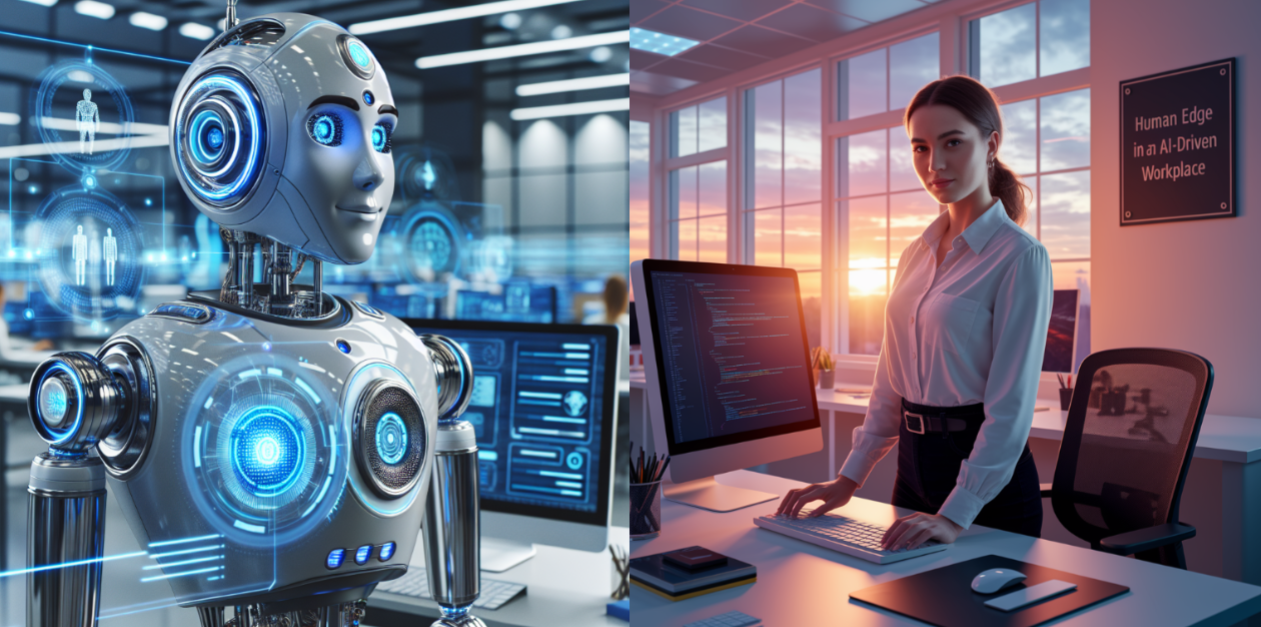In today’s rapidly evolving world, the rise of artificial intelligence (AI) is reshaping the very fabric of the workplace.
While AI excels at automating routine tasks and processing vast amounts of data, it simultaneously underscores the irreplaceable value of uniquely human capabilities – particularly creativity. This isn’t about humans versus machines; it’s about humans with machines, leveraging our strengths to thrive in a new era.
The Creative Skills Revolution 🎨
The automation of repetitive tasks, once a source of anxiety, is now fueling a creative skills revolution. Instead of fearing job displacement, forward-thinking individuals and organizations are recognizing the crucial role of uniquely human skills in the AI-powered workplace. Creativity, critical thinking, complex problem-solving, emotional intelligence, and adaptability are no longer “nice-to-haves” – they’re essential assets driving innovation and success across industries. Employees are actively investing in upskilling and reskilling initiatives, focusing on areas where human ingenuity remains unmatched.
Why Creativity Matters in the Age of AI 🤖
The importance of creativity in an AI-driven world cannot be overstated:
- Innovation and Breakthrough Problem-Solving 🚀: AI excels at analyzing existing data and identifying patterns 🔍. However, it’s human creativity that generates novel ideas, identifies unconventional solutions, and pushes the boundaries of what’s possible. This is especially critical in navigating complex, ambiguous challenges where AI alone falls short. Think of the creative leaps needed to develop entirely new products, services, or business models.
- Emotional Intelligence and Human Connection 🌍 : AI may process information faster than any human, but it lacks the emotional intelligence to understand and respond effectively to human needs and emotions. Empathy, nuanced communication 💬, and the ability to build strong relationships are paramount for effective leadership, client interaction, and team collaboration. These skills are crucial for creating positive work environments and fostering trust.
- Adaptability and Resilience 🔄: The business landscape is constantly shifting. AI technologies themselves are evolving at an unprecedented pace. Creativity empowers individuals and organizations to adapt quickly to change, embrace new technologies, and navigate unforeseen challenges with resilience and innovation. The ability to think outside the box is no longer a luxury; it’s a necessity for survival and growth.
- Strategic Foresight and Ethical Considerations 🧐: AI raises complex ethical questions about bias, fairness, and transparency. Creative thinking is crucial for anticipating the potential consequences of AI implementations and designing systems that align with human values and ethical principles. This requires visionary thinking and the ability to anticipate future challenges.
Building a Creative Skillset 🛠️
Organizations must actively cultivate a culture that values and supports the development of creative skills. Here are some effective strategies:
- Targeted Training Programs 🎯: Invest in workshops, training sessions, and mentorship programs that focus on creative thinking techniques, design thinking, problem-solving methodologies (like Design Thinking or Lean Startup), and innovation frameworks. These programs should go beyond theoretical knowledge and provide practical, hands-on experience.
- Fostering Collaboration and Knowledge Sharing 🤝: Create opportunities for cross-functional collaboration, brainstorming sessions, hackathons, and idea jams to encourage the free flow of ideas and spark innovation. Implement knowledge-sharing platforms and encourage employees to learn from each other’s experiences.
- Embracing a Growth Mindset 🌱: Cultivate a culture where experimentation, risk-taking, and learning from failures are not only accepted but actively encouraged. Provide constructive feedback mechanisms that focus on learning and improvement rather than blame.
- Providing Creative Autonomy and Resources 🧑💼: Empower employees by granting them the autonomy to pursue creative projects and providing the necessary resources (time, budget, tools) to bring their ideas to fruition.
- Leveraging AI to Augment Creativity 🤖: Ironically, AI tools can themselves be used to enhance human creativity. For example, AI can assist with brainstorming, ideation, and prototyping, freeing up human time and resources to focus on higher-level creative thinking.
The Future of Work: A Symbiotic Relationship Between AI and Human Skills ⚖️
The future of work isn’t a zero-sum game. It’s about finding a synergistic relationship between AI and human skills. AI can handle the repetitive, data-heavy tasks, while humans focus on creativity, critical thinking, emotional intelligence, and strategic decision-making. This symbiotic relationship allows for increased productivity, efficiency, and innovation.
Conclusion✨:
Embracing creativity is not merely an adaptation to the rise of AI 🏆; it’s a strategic imperative for individual success and organizational growth. By fostering a culture that values and nurtures creative thinking, organizations can not only prepare their workforce for the future but also unlock unprecedented levels of innovation 🚀 and competitive advantage. The future of work is not solely defined by technology; it’s defined by the power of human ingenuity, amplified by technology. 🌍
Ready to dive deeper into the world of automation? Check out Make.com for powerful tools that can help you streamline your processes and maximize efficiency! https://techbizaitrust.com Post Content on your Socials, check out https://mymarky.ai/?fpr=techbiz74
